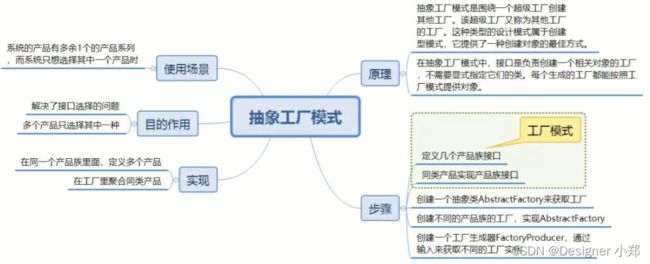JAVA设计模式3:抽象工厂模式,这是一种创建型设计模式
作者主页:Designer 小郑
作者简介:3年JAVA全栈开发经验,专注JAVA技术、系统定制、远程指导,致力于企业数字化转型,CSDN学院、蓝桥云课认证讲师。
主打方向:Vue、SpringBoot、微信小程序
本文讲解了 Java 设计模式中的抽象工厂模式,并给出了样例代码,抽象工厂模式是一种创建型设计模式,它提供了一种创建一系列相关或相互依赖对象的接口,而无需指定其具体类。
目录
- 一、什么是抽象工厂模式
- 二、抽象工厂模式实例
- 三、抽象工厂模式的应用场景
- 四、抽象工厂模式面试题
- 五、总结
一、什么是抽象工厂模式
抽象工厂模式是一种创建型设计模式,它提供了一种创建一系列相关或相互依赖对象的接口,而无需指定其具体类。
在抽象工厂模式中,有一个抽象工厂接口,该接口声明了一些创建不同产品的方法。具体的工厂类实现了该接口,并负责创建具体的产品对象。每个具体的工厂类都对应着一组相关的产品。
抽象工厂模式的核心思想是将对象的创建与对象的使用分离开来。通过使用抽象工厂模式,客户端代码可以通过工厂接口来创建产品对象,而不需要直接依赖于具体的产品类。这样可以实现客户端与具体产品的解耦,提高代码的灵活性和可扩展性。
抽象工厂模式适用于以下 3 3 3 个场景,请同学们认真学习。
- 需要创建一系列相互关联或相互依赖的产品对象。
- 需要在运行时动态决定创建哪种具体产品。
- 需要隐藏具体产品的实现细节,只对外提供抽象接口。
总结来说,抽象工厂模式通过提供一个抽象工厂接口和具体工厂实现类,实现了对象的创建和使用的解耦,提供了一种灵活的方式来创建一系列相关的产品对象。
二、抽象工厂模式实例
下面是一个简单的 Java 代码示例,演示了如何使用抽象工厂模式创建不同操作系统的按钮和文本框。
首先,我们定义一个抽象的 GUI 组件接口和两个具体的实现类,代码如下。
// 抽象产品接口 - 按钮
interface Button {
void render();
}
// 具体产品 - Windows按钮
class WindowsButton implements Button {
@Override
public void render() {
System.out.println("Rendering a button in Windows style.");
}
}
// 具体产品 - MacOS按钮
class MacOSButton implements Button {
@Override
public void render() {
System.out.println("Rendering a button in MacOS style.");
}
}
// 抽象产品接口 - 文本框
interface TextBox {
void render();
}
// 具体产品 - Windows文本框
class WindowsTextBox implements TextBox {
@Override
public void render() {
System.out.println("Rendering a text box in Windows style.");
}
}
// 具体产品 - MacOS文本框
class MacOSTextBox implements TextBox {
@Override
public void render() {
System.out.println("Rendering a text box in MacOS style.");
}
}
接下来,我们定义一个抽象工厂接口,用于创建 GUI 组件,代码如下。
// 抽象工厂接口
interface GUIFactory {
Button createButton();
TextBox createTextBox();
}
// 具体工厂 - Windows工厂
class WindowsGUIFactory implements GUIFactory {
@Override
public Button createButton() {
return new WindowsButton();
}
@Override
public TextBox createTextBox() {
return new WindowsTextBox();
}
}
// 具体工厂 - MacOS工厂
class MacOSGUIFactory implements GUIFactory {
@Override
public Button createButton() {
return new MacOSButton();
}
@Override
public TextBox createTextBox() {
return new MacOSTextBox();
}
}
最后,我们使用抽象工厂创建具体的 GUI 组件,代码如下。
public class Main {
public static void main(String[] args) {
// 创建Windows风格的GUI组件
GUIFactory windowsFactory = new WindowsGUIFactory();
Button windowsButton = windowsFactory.createButton();
TextBox windowsTextBox = windowsFactory.createTextBox();
windowsButton.render();
windowsTextBox.render();
// 创建MacOS风格的GUI组件
GUIFactory macOSFactory = new MacOSGUIFactory();
Button macOSButton = macOSFactory.createButton();
TextBox macOSTextBox = macOSFactory.createTextBox();
macOSButton.render();
macOSTextBox.render();
}
}
输出结果会根据不同的操作系统风格而有所不同,例如在 Windows 系统下,输出将是如下所示。
Rendering a button in Windows style.
Rendering a text box in Windows style.
而在 MacOS 系统下,输出将是如下所示。
Rendering a button in MacOS style.
Rendering a text box in MacOS style.
通过使用抽象工厂模式,我们可以实现根据不同的工厂来创建不同风格的 GUI 组件,而无需直接依赖于具体的产品类。
这样可以提高代码的灵活性,使得我们能够轻松地切换和扩展不同风格的 GUI 组件。
三、抽象工厂模式的应用场景
抽象工厂模式适用于以下场景:
- 需要创建一系列相关或相互依赖的产品对象:抽象工厂模式可以帮助我们创建一系列相关的产品对象,这些产品对象之间有一定的关联或依赖关系。例如,在一个游戏中,我们可能需要创建不同阵营的角色、武器和装备,这些产品之间有一定的关联性。
- 需要在运行时动态决定创建哪种具体产品:抽象工厂模式允许我们在运行时根据条件或配置来决定创建哪种具体产品。这种灵活性使得我们可以根据不同的需求来创建不同的产品。
- 需要隐藏具体产品的实现细节:抽象工厂模式将产品的创建和使用进行了解耦,客户端只需要关注抽象工厂接口和产品接口,而不需要关心具体产品的实现细节。这样可以提高代码的可维护性和可扩展性。
- 需要满足开闭原则:抽象工厂模式可以满足开闭原则,即对扩展是开放的,对修改是关闭的。通过添加新的具体工厂和产品类,我们可以轻松扩展抽象工厂模式的功能,而不需要修改现有的代码。
抽象工厂模式适用于那些需要创建一系列相关或相互依赖的产品对象,并且需要在运行时根据条件或配置来决定创建具体产品的情况下。它可以帮助我们实现代码的灵活性、可维护性和可扩展性。
四、抽象工厂模式面试题
- 什么是抽象工厂模式?它解决了什么问题?
- 抽象工厂模式和工厂方法模式有什么区别?
- 抽象工厂模式的角色有哪些?
- 你能给一个简单的抽象工厂模式的实例吗?
- 你认为抽象工厂模式在哪些场景下使用得最好?
五、总结
本文讲解了 Java 设计模式中的抽象工厂模式,并给出了样例代码,在下一篇博客中,将讲解 Java 原型模式。
![]()



